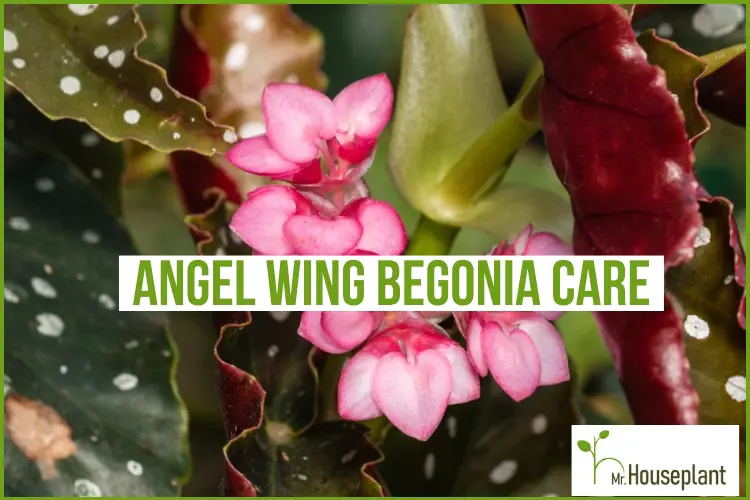
You spotted a gorgeous Angel Wing Begonia plant and you would like to buy it, but as a rookie plant parent, you’re worried you won’t be up to the challenge. Put your worries to rest, because we’ve answered all your questions in this comprehensive Angel Wing Begonia growing guide. Keep reading, and you will learn how and when to repot your plant, what is the best soil, how and when to prune it, what fertilizer to use, plus everything else you need to know to grow and care for Angel Wing Begonias.
| Botanical Name (Latin Name/Scientific Name): | Begonia Coccinea |
| Common Name: | Angel Wing Begonia |
| Light: | medium light (1,000 lux – 2,500+ lux) |
| Watering: | once the top half of the soil is dry |
| Soil: | well-draining mix |
| Repotting: | Once a year |
| Temperature: | 60°F to 75°F (16°C to 24°C) |
| Humidity: | 25% to 50%, but it adapts well to lower humidity |
| Toxicity for Pets: | Yes |
| Toxicity for Humans: | No, but it can cause irritation in some people |
| Propagation: | tip cuttings/stem cuttings in water or soil
leaf cuttings division |
| Pruning: | Prune dead or diseased growth or when you want the plant to branch out |
Light Requirements
| Minimal amount of light: | 1,000 lux (100 FC) |
| Optimal amount of light: | 2,500+ lux (250+FC) |
| Direct sun tolerance: | 1-2 hours |
| Category: | medium light |
Angel Wing Begonias thrive in bright, indirect light. The minimal amount of light for this plant is 1,000 lux (100 FC). The optimal amount of light for your Begonia is 2,500+ lux (250+ FC). If you can provide more bright indirect light, for example, 10,000 lux (1,000 FC) or even 15,000 lux (1,500 FC), your Angel Wing Begonia plant will grow faster year round, because it will photosynthesize more. More photosynthesis means more energy for the plant, which makes it more robust, healthier, and more resistant to pets and plant diseases.
Just keep in mind not to expose your Angel Wing Begonia plant to too much direct sunlight, or its leaves will get burnt, curled, and become crispy. The best way to provide the optimal amount of light is to place your Begonia in front of the brightest window with an unobstructed view of the sky, or on the window ledge.
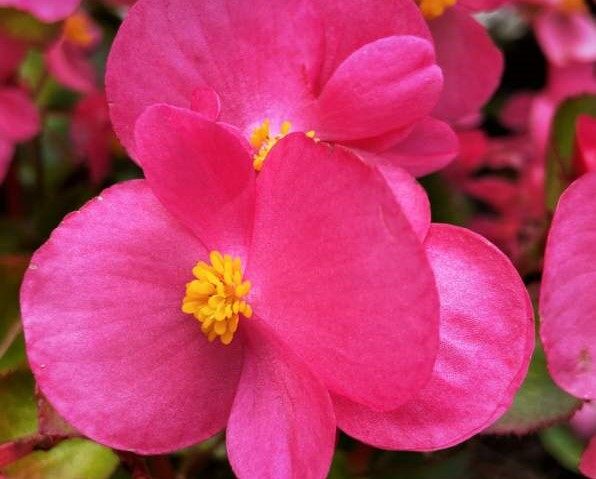
Begonia plant care includes plenty of bright indirect light that makes your plant bloom
Water Needs
You should water your Angel Wing Begonia when the top half of the soil dries out. How often you must water your plant will depend on lots of factors, such as the amount of light, type of pot, type of soil, humidity, etc. If you’re unsure whether the top half of the soil is dry, you can use a chopstick. Stick the chopstick to the bottom of the pot, and pull it out. If it has no soil on the top half on it, it’s ready for watering. Otherwise, allow the soil to dry enough before watering. It’s important to keep your Begonia in a pot with well-draining soil to prevent the soil from getting soggy since this can cause fungal diseases and root rot.
Potting Soil for Growing Begonia Coccinea
To make the best soil mix for your Begonia, mix:
- 2 parts of the potting mix
- 1 part of perlite or another amendment
The best choice for Begonia Coccinea is a well-draining, porous potting mix that contains a lot of oxygen. Using an oxygen-rich potting mix is vital because roots need oxygen to grow. It also reduces the chances of overwatering and bacterial or fungal infections which lead to root rot. You can either use a potting mix that is oxygen-rich, or you can create your own.
If you want an oxygen-rich potting mix, use high-quality potting soil, such as Mother Earth Groundswell. This potting mix is good straight out of the bag and doesn’t need to be amended with anything. Another option is to make your own potting mix by taking a commercial potting mix and mixing it with perlite or another inorganic amendment. Use 2 parts soil and 1 part perlite. Using amendments with large particle sizes creates macro-pores filled with oxygen. This keeps the soil loose and porous and reduces soil compaction. Choosing the proper soil mix will help you in growing Angel Wing Begonias.
Humidity Needs
Like most other begonias, Angel Wing Begonias prefer medium humidity (25% to 50%), however, they adapt very well to low humidity. They will do just fine in your home, it’s not mandatory to have high humidity to grow Angel Wing Begonia plants that are beautiful and healthy.
Temperature Requirements
The optimal temperature for Angel Wing Begonias to grow is between 60°F to 75°F (16°C to 24°C). Angel Wings are sensitive to frost and low temperatures, so make sure not to expose them to temperatures lower than 50 degrees Fahrenheit (10 degrees Celsius). Low temperatures can damage the foliage of the Angel Wing Begonia plant.
Fertilizing
To fertilize your Angel Wing Begonia, use a high-quality liquid fertilizer like The Sill fertilizer. Mix 1 teaspoon of the fertilizer with a gallon of water and use it once a month. If you use another fertilizer, don’t forget to read the instructions on the fertilizer package, since it’s possible to overdo it. If you fertilize your begonia too much, the roots can get damaged and burned, and you can even kill your Angel Wing Begonia plant.
There’s no need to wait for spring and summer to fertilize your Begonia. As long as your plant is actively growing, you can fertilize it. If it’s not growing, fertilizing will cause the minerals to accumulate in the soil, and the Angel Wing Begonia plant won’t be able to use them. Once the minerals accumulate in too high quantities, they will start damaging the roots and the plant.
If you repot your Begonia plant annually, it is not necessary to fertilize it, since it will get nutrients from the fresh soil.
Repotting
This is how to repot your Angel Wing Begonia:
- Choose a pot that is slightly larger in diameter than the one you’ve been using
- Remove the plant from its pot
- Loosen the rootball and inspect the roots
- If you notice that the roots are dying, mushy, or smelly, prune them
- Fill one-third of the new pot with well-draining, porous potting soil
- Place your Begonia in its new pot
- Fill in the space with soil
- Press well the soil around the Angel Wing Begonia plant
- Water it
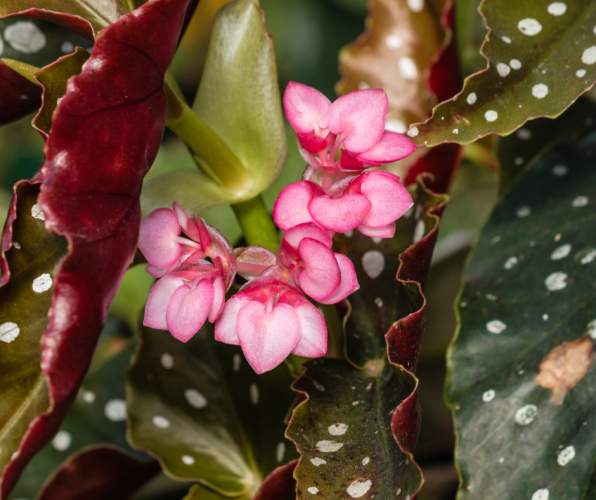
Repotting your Begonia at least once a year will provide the plant with nutrients and boost its growth
Make sure to go just one size up when choosing a new pot, i.e. choose a pot that is 2” (5 cm) wider than the previous pot. If you repot your indoor plant in a much bigger pot, the soil will remain wet much longer, which is a perfect ground for fungal diseases and root rot.
When you loosen the rootball, do it thoroughly, on all sides, not only on the bottom. By doing this you will enable your plant’s entire roots to spread evenly and grow well in their new home. Pruning diseased root parts is important because it keeps your plant healthy and prevents any diseases from spreading.
How will you know if your Angel Wing Begonia plant needs repotting:
- It’s been a year or more since the last repotting
- The roots are coming out of the drainage holes (the plant needs more space)
- If you pull the plant out of the pot and you see a large rootball, with not a lot of soil (the plant needs new, fresh soil with nutrients)
- You need to water the plant much more frequently than in the past
Toxicity For Humans
According to the University of California, Angel Wing Begonias are generally safe and not toxic to humans, but they may cause vomiting or diarrhea in some people.
Toxicity For Pets
The ASPCA states that the Angel Wing Begonia plant is toxic to cats and dogs because it contains soluble calcium oxalites, which cause vomiting and salivation. The most toxic part of the plant is its root.
Pruning
You can prune your Angel Wing Begonia in the below-listed cases:
- if it has diseases or pests
- if the leaves are dead (dry and brown)
- if you want your plant to be bushier
- if you want to propagate it
Pruning diseased or dead plant parts is a great way to maintain your Angel Wing Begonia health. If your Begonia is healthy, you can prune it if you want the plant to branch out below the cut. Otherwise, you don’t have to prune a healthy plant. If you want to propagate it from a stem or a leaf, you can prune them.
Types of Angel Wing Begonia
There are many different Angel Wing Begonia varieties, and these are among the most popular ones:
Splish Splash
Splish Splash Begonia was created in 1991 by Walter Dworkin. It is characterized by white splashes on dark green leaves. Splish Splash begonia boasts beautiful magenta or deep pink flowers. Like other Angel Wing varieties, it is a cane begonia, which means that it has a tough, bamboo-like stem.
Silver Wings
Silver Wings Begonia’s origins go back to 1990, and it is characterized by a silver-spotted and medium-green hue on its foliage.
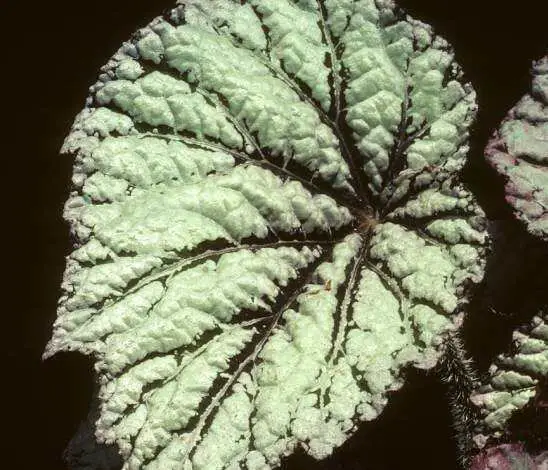
Silver Wing variety with characteristic foliage
Looking Glass
Looking Glass begonia was created by hybridizer Patrick J. Worley in 1981. This begonia displays silver leaves with olive-colored green veins and bright pink flowers.
Angel Wing Begonia Propagation
You can propagate Angel Wing Begonias in a few ways:
- tip/stem cutting in water or in soil
- leaf cuttings
- division
The easiest way to propagate your Begonia is by tip/stem cutting in water, and this is how you do it:
- Begin by sterilizing the pruning shears or scissors
- Choose a stem that doesn’t have flowers, it should have at least two leaves and two growth nodes
- Cut the stem below the second growth node
- Remove the bottom leaves from the stem cutting and place the cutting in a glass or jar filled with water
- Keep the glass in indirect, bright light
- New roots will form quite quickly, in about two weeks
- When the new roots reach 2-3 inches in length, it’s time to plant the stem cutting in the soil
Sterilizing your cutting tools is important since you don’t want to accidentally contaminate the stem with bacteria, pests, or fungi. When it comes to choosing the right stem, choose a healthy, robust stem without flowers or flower buds. If you take a stem with flowers it will use the energy to bloom instead of using it to develop new roots.
Taking a slightly longer stem with two growth nodes increases the chances of successful propagation. When placing the stem cutting in water, make sure to submerge both growth nodes, but keep the leaves above the water, as they would otherwise rot. Bright, indirect light will speed up the process and boost root growth.
Common Problems
Leaves Turning Yellow
If the leaves of your Angel Wing Begonia are turning yellow, there are multiple possible culprits: the natural growth cycle in which old leaves are falling off, underwatering or overwatering, and pests or diseases. The first step is to ensure your Begonia gets the right amount of water. Don’t let the soil dry out completely, but on the other hand, don’t overwater the plant and let it sit in soggy soil.
When it comes to diseases that cause the leaves to turn yellow, pythium root rot is the one to blame. This fungus attacks the roots and stems of the plant and causes wilting and yellowing of lower leaves. To prevent this fungal infection, sterilize the pot and your tools, and don’t overwater your Angel Wing Begonia plant. We also have a blog about cinnamon for houseplants as an antifungal that you can check.
Brown Leaf Edges
If your Begonia starts developing brown leaf edges it is either underwatered, exposed to too much direct sunlight, or it’s suffering from a fungal disease. Remember to water your begonia when the top half of the soil dries out, and preferably use bottom watering to avoid potential fungal infection. Fill the pot’s saucer with water and let your plant soak up the water through the drainage holes. Don’t mist your plant as this can lead to fungal infections.
Begonias can tolerate only 1 to 2 hours of weak direct sunlight, in the early morning or late afternoon. Otherwise, the leaves can be sunburnt and turn crispy.
Myrothecium leaf spot is a fungal disease that causes lesions at the leaf edges and tips. The affected areas are dark-brown. The best way to prevent this is to minimize wounding the plant physically and fertilize your begonia at recommended levels.
Oedema On The Leaves
Raised swellings that resemble scabs on the underside of Angel Wing Begonia leaves are called oedema. They indicate inadequate light levels or overwatering. The scabs look like water-filled blisters initially, and with time they turn to rusty-brown color. This can be prevented by providing adequate light and paying close attention to maintaining adequate soil moisture levels. If you don’t have enough natural light in your home, the best way to give your Begonia plant optimal light is to build a plant shelf with grow lights.
Angel Wing Begonia Most Common Pests And Diseases
Like other Begonias, Angel Wing Begonia is susceptible to certain fungal infections, pest infestation, and viral and bacterial diseases.
Fungal Diseases
The most common fungal infections are:
Powdery Mildew
Botrytis Blight
Pythium Root Rot
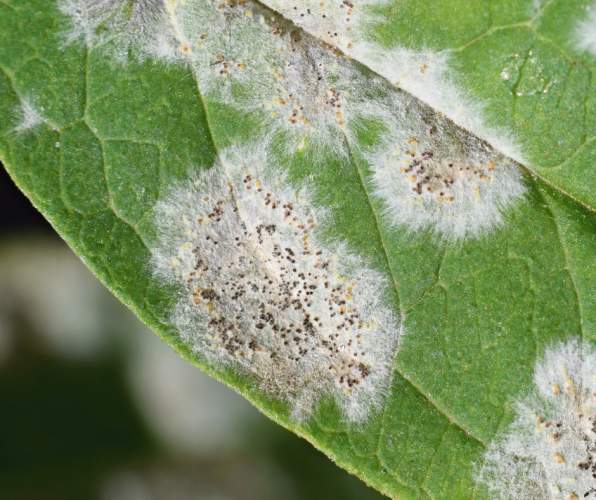
Powdery Mildew on the underside of a leaf
Powdery Mildew appears as white, mealy fungal growth on stems, flowers, and leaves. It usually occurs in hot, humid weather. This disease can be stopped by carefully examining the plant and pruning affected areas promptly.
Botrytis Blight is characterized by moldy gray patches on stems, leaves, and buds. It generally happens when the weather is hot and humid. The affected tissue should be removed. Good air circulation can help prevent Botrytis Blight.
Pythium Root Rot causes shiny dark areas on petioles and stems. Foliage starts to wilt and turns yellow. This disease is difficult to treat, so it’s best to prevent it by avoiding overwatering, especially in the crown area of the plant.
Avoid misting, as it can promote fungal infections.
Pests
The most common Angel Wing Begonia pests are:
- Mealy Bugs
- Mites (Broad Mite)
- Thrips
- Spider Mites
Mealy Bugs are white, soft insects with a waxy appearance. A telltale sign of mealy bugs infestation is a white wooly substance that they secret. If you notice the infestation in the early phase, you can use a cotton swab dipped in rubbing alcohol and remove the mealy bugs.
Broad Mites cause the leaves to become brittle, curled, and discolored. If you notice diseased parts, prune them as soon as possible. If the infestation is more severe, it’s advisable to use a miticide, neem oil, horticultural oil, or insecticidal soap.
Thrips are small and thin insects whose color varies from yellow to light brown. Affected leaves become distorted and curled, with silver-gray scars. To prevent thrips infestation, keep your Begonia well-lit, well irrigated, and avoid excessive usage of nitrogen fertilizer, which can lead to higher populations of thrips. To treat thrips infestation, use a systemic insecticide, otherwise, thrips are very difficult to get rid of.
Spider Mites have eight legs and an oval body. They cause damage to plants by sucking cell contents from leaves. When the infestations is high, you will notice webbing on the leaves. To treat a spider mite infestation, treat your Begonia with a miticide, neem oil, insecticidal soap, or horticultural oil twice a week, until all spider mites are gone.
Bacterial Diseases
The most common bacterial disease affecting Angel Wing Begonias is
- Xanthomonas leaf spot
Xanthomonas leaf spot causes speckling of the foliage and necrosis at the edges. To prevent leaf spot avoid overhead watering and use sterilized potting mediums.
Viral Diseases
Angel Wing Begonia is commonly affected by the following viruses:
- Impatiens Necrotic Spot Virus
- Tobacco Ring Spot Virus
- Cucumber Mosaic Virus
These viruses cause malformed leaves, stunted growth, mottling of leaves, and pale yellow ring spots. The best prevention is using pasteurized potting media, and discarding infected plants to prevent spreading, since these viruses are incurable.
FAQs about Angel Wing Begonia Care
What is the best indoor environment for an Angel Wing Begonia?
The best indoor environment for an Angel Wing Begonia is an environment with bright indirect light (light over 3,000 lux), with temperatures between 60°F to 75°F (16°C to 24°C), potted in a well-draining, porous potting mix.
How do I keep my Angel Wing Begonia bushy?
To keep your Angel Wing Begonia bushy, you should prune it, and it will branch out below the cut. This will promote new growth and you will get a more compact plant with beautiful lush foliage.
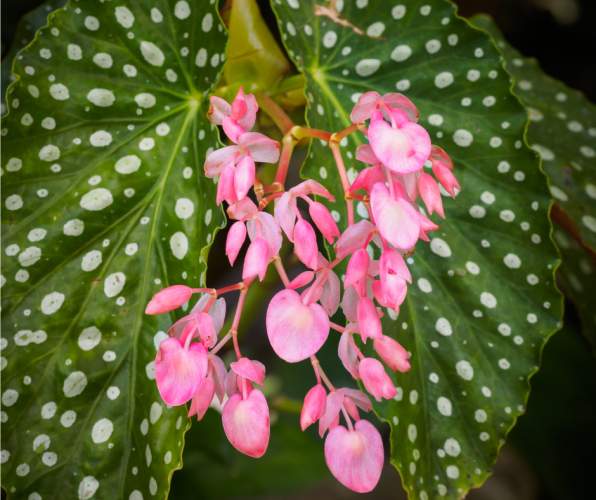
Stunning Begonia flowers in vivid pink color
When Should I Begin To Prune My Plant?
You should prune your plant in two scenarios: if it has sick or dying parts caused by pests or disease, or if you want your Begonia to become bushier. If it has sick or dying parts, you should cut those parts off. If you want your plant to become bushier, prune it and it will branch out below the cut.
Can Angel Wing Begonias Be Grown From Seed?
Yes, Angel Wing Begonias can be technically grown from seed, but your best bet is propagation by stem cuttings. Since these tropical plants are hybrids, you will not get the exact copy of the parent plant. However, propagating Angel Wing Begonias by stem cuttings is easy, and more reliable in terms of getting the same-looking plants.
How Long Does An Angel Wing Begonia Live?
Angel Wing Begonia lives up to 5 or 6 years. After this time, it will start to lose its vigor and die. When your plant reaches this age, make sure to propagate it so you can have new plants.
Why Doesn’t My Angel Wing Begonia Get Flowers?
Your Angel Wing Begonia doesn’t get flowers because it gets insufficient light. Flowering plants need more energy to produce flowers than their non-flowering counterparts, and they get this energy from light. Make sure to give your Begonia the optimal amount of light so it can blossom and show off those gorgeous pink flowers.
Conclusion
Angel Wing Begonias, like many other houseplants, are easy to care for indoors. These plants will grow and bloom in your indoor garden with proper Begonia plant care. Make sure to provide all conditions that they need.
Yours Truly,

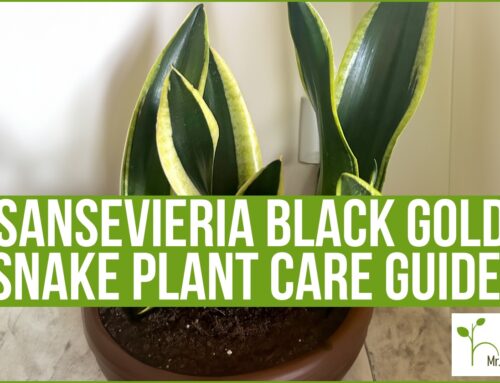

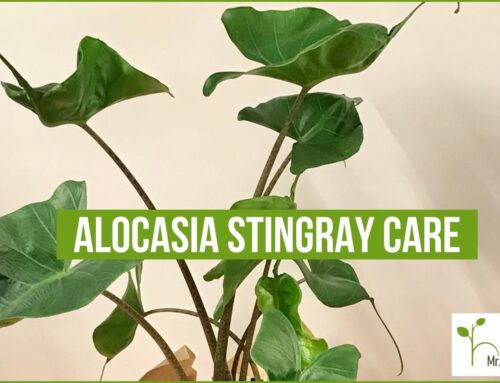

Why is my plant fading? The underside is not purple anymore.
Hi Teresa, your plant is most likely not receiving enough light. Have you tried measuring light with a light meter? If you don’t have a light meter, move the plant in front of the brightest window you have, with an unobstructed view of the sky. Don’t place the plant behind a wall, but right in front of a window. Give it a few weeks and let’s see if new leaves develop a purple color. You could also get a grow light if you don’t get a lot of natural light :)
Hello! The veiny structures under the leaves of my begonia are turning brown. It starts where the leaf connects to the stem and then creeps it way further down the underside of leaf. Do you know what could be causing this? Thanks!
Hi Beverly, I would have to see a photo to be able to diagnose. Feel free to send me one on Instagram.
Why is my angel wing begonia loosing it’s white spots
Hi My Angel Wings are developing small brown spots on the underside of the leaves. Not all but some. They are still flowering but all three plants have developed the cluster of brown spots on several wings.
Hi Damien, I’m afraid it’s hard to diagnose without seeing photos. Brown spots could be an issue with overwatering, compacted soil, overfertilizing, sunburns or other issues. If you can send me a photo on Instagram, I can help 🙂
I have a picture. How do I send it to you?
Why is my Angel wing begonia getting thin watery /mushy spots on the leaves?
Hi Sharon, it could be a fungal disease (Botrytis blight, Myrothecium leaf spot or Southern blight). Hard to say for sure without seeing the photos. But if it is fungal, discard all infected leaves.